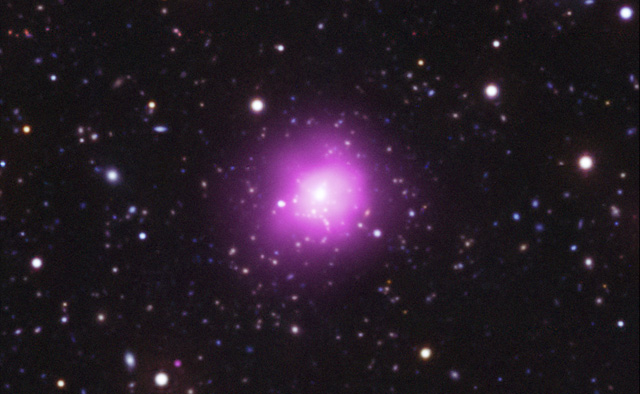Kazi Abul Monsur#
Recently, astronomers have identified an extremely massive supermassive black hole in the Phoenix Galaxy Cluster, believed to be one of the largest ever discovered in the universe. It is estimated to be several hundred billion times more massive than our Sun.
The Phoenix Cluster, located approximately 5.7 billion light-years from Earth, is an extremely bright and gas-rich galaxy cluster. Researchers have confirmed that this enormous black hole is situated at the center of the cluster’s central galaxy.
This discovery offers new insights into the evolution and impact of black holes in our universe. The black hole is actively devouring surrounding gas and dust, emitting intense radio and X-ray radiation—observations that brought it to scientists’ attention.
According to experts, such massive black holes can significantly influence galaxy formation, star birth rates, and even the temperature of galaxy clusters.
At the center of our familiar Milky Way galaxy lies a supermassive black hole known as Sagittarius A*, which is estimated to be approximately 4.297 million times more massive than our Sun. However, it is far from being the largest. There may be black holes hidden in this vast universe that are thousands of times more massive and destructive.
Recently, using the high-tech Event Horizon Telescope (EHT), scientists have detected the possible existence of an ultra-supermassive black hole—one so immense and powerful that it has sparked massive excitement in the astrophysics community. Researchers have named it Phoenix-A*, and its mass is speculated to be about 100 billion times that of the Sun.
Phoenix-A* is located in the Phoenix Cluster, roughly 5.8 billion light-years away from our solar system. It is estimated to have a diameter of approximately 366 billion miles. The central galaxy of the Phoenix Cluster is known as Phoenix-A, an elliptical galaxy which may house this ultra-supermassive black hole at its core.
The Phoenix Cluster (SPT-CL J2344-4243) is a massive Abell-type I galaxy cluster, located in the southern constellation of Phoenix. It was initially discovered in 2010 during a 2,500-square-degree sky survey using the South Pole Telescope and employing the Sunyaev-Zel’dovich effect. It remains one of the largest known galaxy clusters in the universe.
To date, the Phoenix Cluster is the brightest known X-ray cluster, emitting more X-rays than any other known large cluster. It is approximately 8.61 billion light-years (2.64 gigaparsecs) from Earth. Around 42 local galaxies have been identified within it so far, and it is currently listed in the SIMBAD astronomical database. However, scientists believe it may host more than 1,000 galaxies in total.
It should be noted that the information and data related to Phoenix-A* are based on scientific observations and theoretical predictions. Some details may be speculative or not fully consistent with currently verified scientific data. For example, the most massive known supermassive black hole to date is TON 618, estimated at around 66 billion solar masses, followed by the black hole at the center of Abell 1201, with a mass of about 40 billion solar masses.
Previous research on the black hole in the Phoenix Cluster estimated its mass to be around 20 billion solar masses. However, the recent claim that Phoenix-A* is 100 billion solar masses has not yet been supported or confirmed by major scientific institutions or reputable platforms such as NASA, ESA, or Space.com.
Based on astronomical models, a black hole with a mass of 100 billion solar masses would likely have a diameter of about 295 billion kilometers, or roughly 0.03 light-years. In contrast, the estimated diameter of the Phoenix-A* black hole is being reported as 366 billion miles, or 590 billion kilometers, which is nearly double the theoretically predicted size—raising doubts about the accuracy of the information.
NASA’s Event Horizon Telescope (EHT) and other current astronomical technologies are designed to observe black holes relatively close to our solar system, such as M87* and Sagittarius A*. Observing a black hole in the Phoenix Cluster, which is about 5.8 billion light-years away, may exceed the technical capabilities of current instruments like the EHT.
Thus, collecting precise data about such a distant black hole remains a significant challenge for scientists. Moreover, this information has not been officially published in reputable international journals such as NASA, ESA, Nature, Astronomy, or The Astrophysical Journal.##



মন্তব্যসমূহ বন্ধ করা হয়.